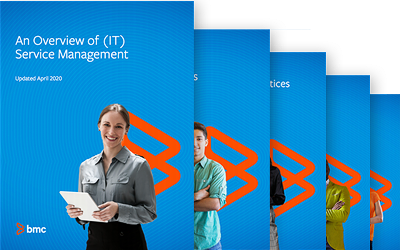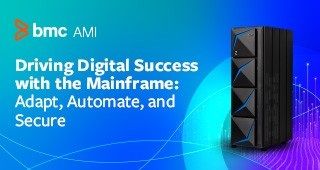In the first half of this blog post, we covered some of the inherent benefits and problems with ITIL—and with DevOps. It would be a mistake to consider DevOps a replacement for ITIL, as they are distinct methodologies, each with their own advantages and potential drawbacks. And while DevOps may rule at the moment, with today’s focus on accelerated development cycles, it’s only a matter of time before another process rolls around to dethrone it. But rather than making or avoiding making decisions out of fear in terms of assessing the best fit for your IT organization and your IT operations in general, instead look for what might be considered an ideal solution.
Download Now: ITIL 4 Best Practice e-Books
These all-new for 2020 ITIL e-books highlight important elements of ITIL 4 best practices. Quickly understand key changes and actionable concepts, written by ITIL 4 contributors.
Consider Agile ITIL: Make operations processes adaptable, automated, and friendly
So if DevOps can’t replace ITIL, and traditional ITIL itself can’t meet DevOps requirements, can ITIL be made more agile by incorporating DevOps principles?
Characteristics of Agile ITIL
By using some core concepts of DevOps, we can transform ITIL to maximize the aspects that today’s operations teams need—flexibility and speed.
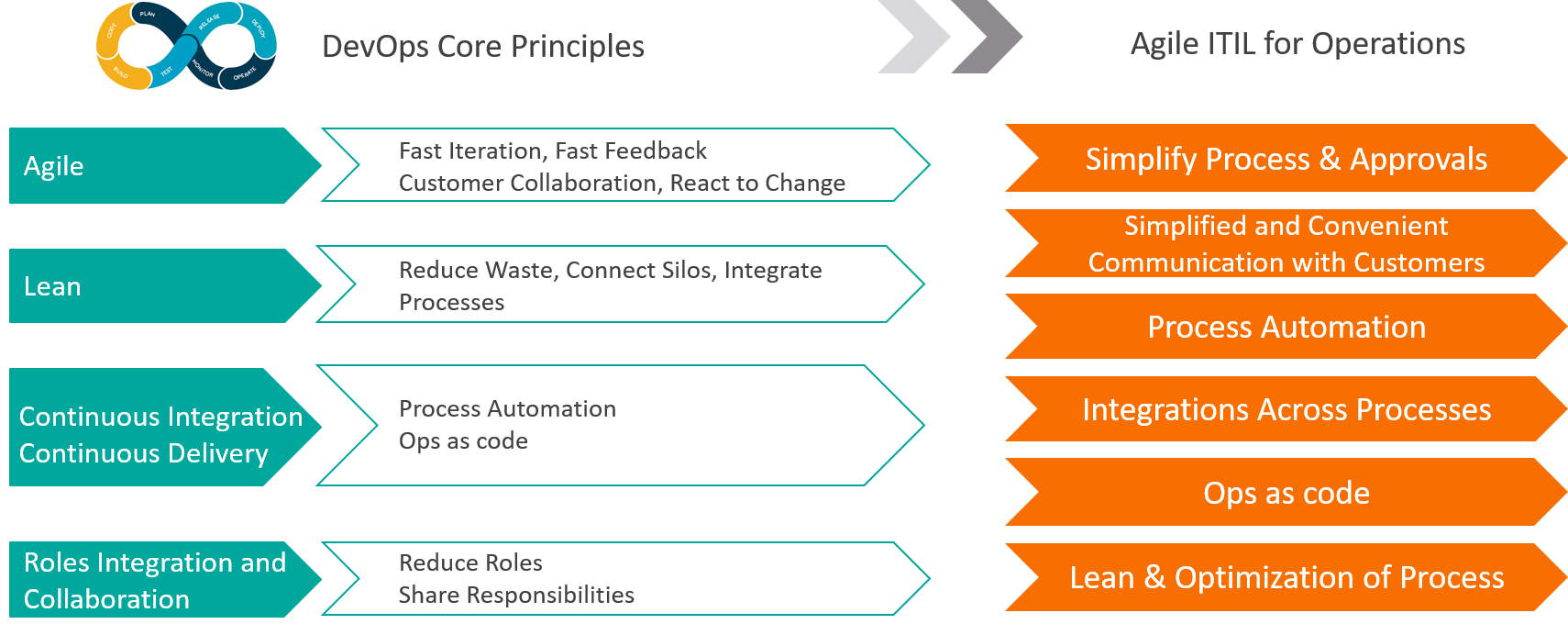
Key points of Agile ITIL
1. Change process automation and integration
As shown in below Figure, implement process integration with change and release automation as the core.

Change and release process components to address:
- Process simplification: Evaluate existing change management process, and remove unnecessary requirements for approvals.
- Change category (standard, normal, major, emergent, etc.) downgrade: Evaluate each sub-category of the existing change process, noting whether its implementation can be automated and whether the risk is controllable, and degrade them into standard change or lower categories.
- Refinement of the standard change process: Evaluate the secondary and tertiary sub-categories of standard changes, mapping the implementation activities into automated scripts or a flow of orchestrated scripts. This way, more and more standard change will be automated in execution.
Process integration with change and release process:
- Incident process integration: For those incidents with low risk, low impact, and standard procedures, the standard change process is automatically triggered by an incident, and the script for repairing is automatically executed.
- Service request process: Assess how to automate the service fulfillment of each service request type, and implement the automation for those types of service request. Integrate the service request with the change and release process for service logging and trace auditing, and then call automation for service delivery.
- Software release process: Make the deployment activity automated by supporting automation platforms, and integrate into the change and release process.
- Job management process: Left-shift the operational responsibility of batch jobs with the development team, and use job-as-code API to generate job tasks and a schedule. Through integration with the change process, they are automatically delivered under central automation orchestration management.
2. Configuration management process automation and integration

Turn CMDB manual management into automated management with the following steps:
- CMDB initialization: Through automated scanning of the managed environment, information collection, relationship discovery and application system modeling of all configuration items (CIs) are completed without manual input. Non-technical information still requires external input; the application model and relationships still need to be refined based on auto-discovery findings.
- Scan and audit daily: With CI automatic discovery at daily (at least) frequency and audit, Ops can automatically compare the difference between the configuration baseline data and the current actual data, and find CI changes. Verified changes can be updated to the CMDB after manual confirmation.
- Integration with change process: Scan the zones where the change will take place and take a snapshot as baseline before the change is implemented; scan again after change implementation, then import new information into the CMDB with manual confirmation.
The core capabilities of auto-discovery include:
- The number of supported devices and software (whether it can achieve the fullest possible coverage of common types, models, and versions in the industry)
- The speed of discovery (to ensure accurate data is received on time from the CMDB)
- Capabilities of support from multi-cloud service providers, etc.
3. Agile communication and support services for users
Use technology that supports mobile, location-based, social, and other popular user preferences to provide IT service users with support through multi-channels (app, instant messaging, web, SMS, etc.) to continuously improve the user’s digital experience and satisfaction.

Furthermore, intelligent customer service (chatbot) can be used to provide personalized service support for users.
4. Process customization based on a graphical configuration
The process platform must be agile and capable of supporting rapid optimization and iteration to continuously meet the needs of IT operations and service support. A process platform that provides process customization based on graphical configuration will reduce the cost, time, and risk of process creation and modification, and serve production operations faster. The platform customization relying on manual code change is becoming a historical legacy.

5. Ops as code
Ops as code is a recent trend in IT operations and maintenance tools. Considering the scale of the managed object, the complexity of the architecture, the dynamics of the scene, and the requirements of real-time management, all operations and maintenance management tools must provide an external API, and the third-party system or code may integrate and manage the logical arrangement to realize dynamic real-time operation and maintenance.

Reference architecture of Agile ITIL
To achieve the above Agile ITIL capabilities and better implement DevOps-style agile operations and maintenance, an implementation architecture is shown in below Figure:

The system can be divided into four layers which include:
User layer: Agile support and communication channels support a variety of service technologies such as mobile, location, and social, introduce intelligent customer service supported by AI, and support services in a more efficient, faster, and user-friendly way.
Presentation layer: Agile operations and maintenance dashboard helps define KPIs for agile operations, display real-time KPIs and historical data in various ways, and demonstrate the efficiency, value, and control afforded by agile operations and maintenance for stakeholders and the management team.
Process management: Focus on the change release management process, automation and integration with other processes, and connection with the automation layer. CMDB configuration management is based on the automatic discovery of CI information.
Automation layer: The automation layer automates the implementation activity of the change and release process including:
- Enterprise-level central automation orchestration and scheduler: Realize logical orchestration of change and release tasks, change window scheduling, resource allocation, process supervision, automation action result feedback to the requested process, etc.
- Automated deployment tools: Dynamically deliver automated scripts to target objects, providing a run-time environment for automated scripts, and acting as a communication channel for automated scripting and orchestration schedulers
- Automated script library: Provides a low-coupling, fine-grained script library for easy programming of complex automation tasks
- Customized scripts: Customized development for users with special requirements that are difficult to implement with existing automated script libraries
- API interface: REST API interface provided by other third-party tools or scripts, called by scripts or orchestrator
BMC Solutions for Agile ITIL
BMC Software, the leading provider of ITIL-enabled solutions, offers a full stack to implement Agile ITIL with the following products and modules:
- BMC Helix ITSM – provides the richest out-of-the-box IT service management capabilities for end users, agents, and operations
- BMC Helix Digital Workplace – provides intuitive and intelligent consumer-like experiences to help organizations step into the future of work
- BMC Helix Platform – helps companies extend, customize, and integrate through REST APIs on a cloud-native, microservices-based platform
- TrueSight Orchestration – coordinates workflows across applications, platforms, and tools to automate critical IT processes
- TrueSight Automation for Servers – allows fast and secure provisioning, configuration, patching, and maintenance of physical, virtual, and cloud servers
- TrueSight Automation for Networks – accelerates reliable network configuration changes to increase agility, reduce costs, and lock down security
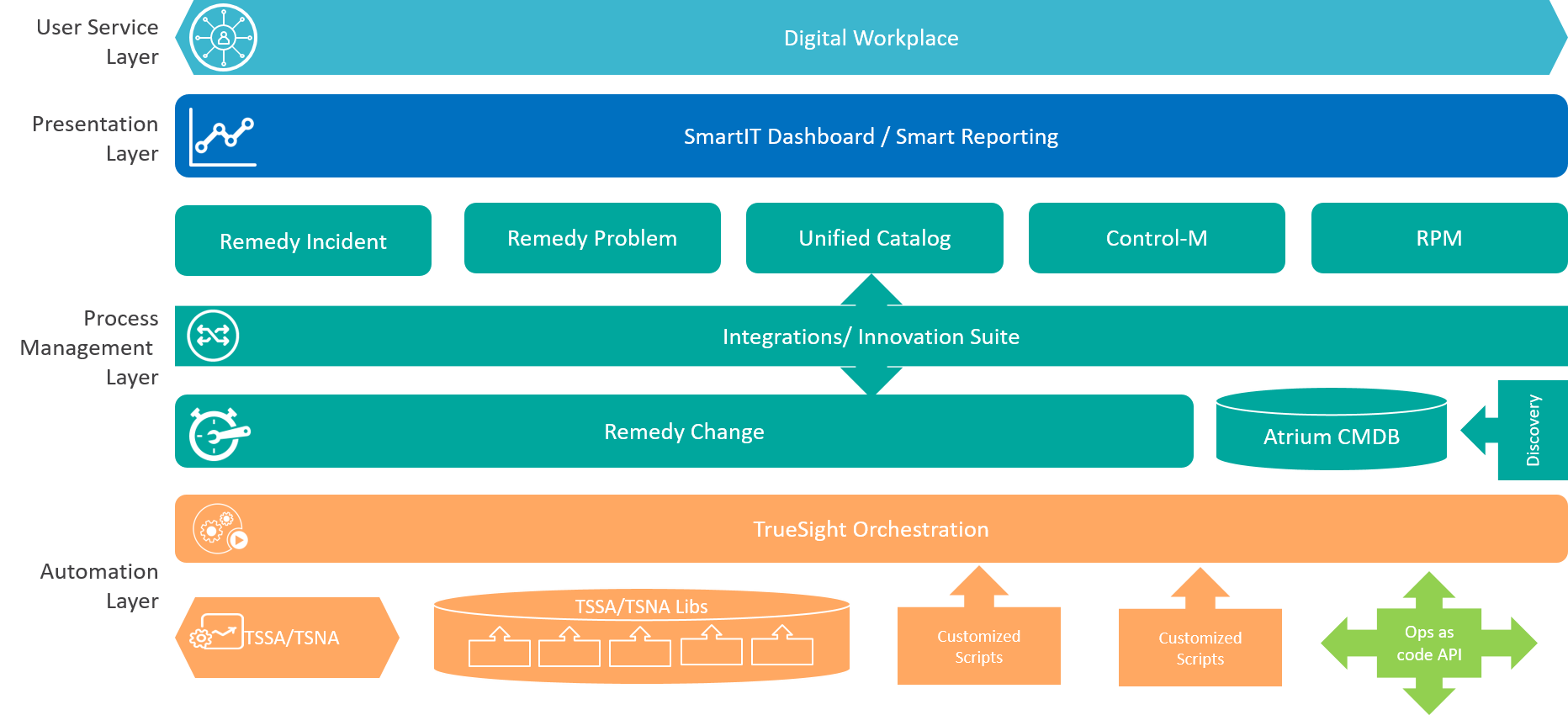
Conclusion
To adapt to the rapid changes in the digital era and when integrated with the DevOps development model, traditional ITIL can be transformed into Agile ITIL. This updated and streamlined development model can be realized through process optimization, integration, and change automation enabled by a complementary suite of products and solutions. The result: improved operational efficiency and stakeholder buy-in, reduced risk, and optimized speed and innovation capabilities.
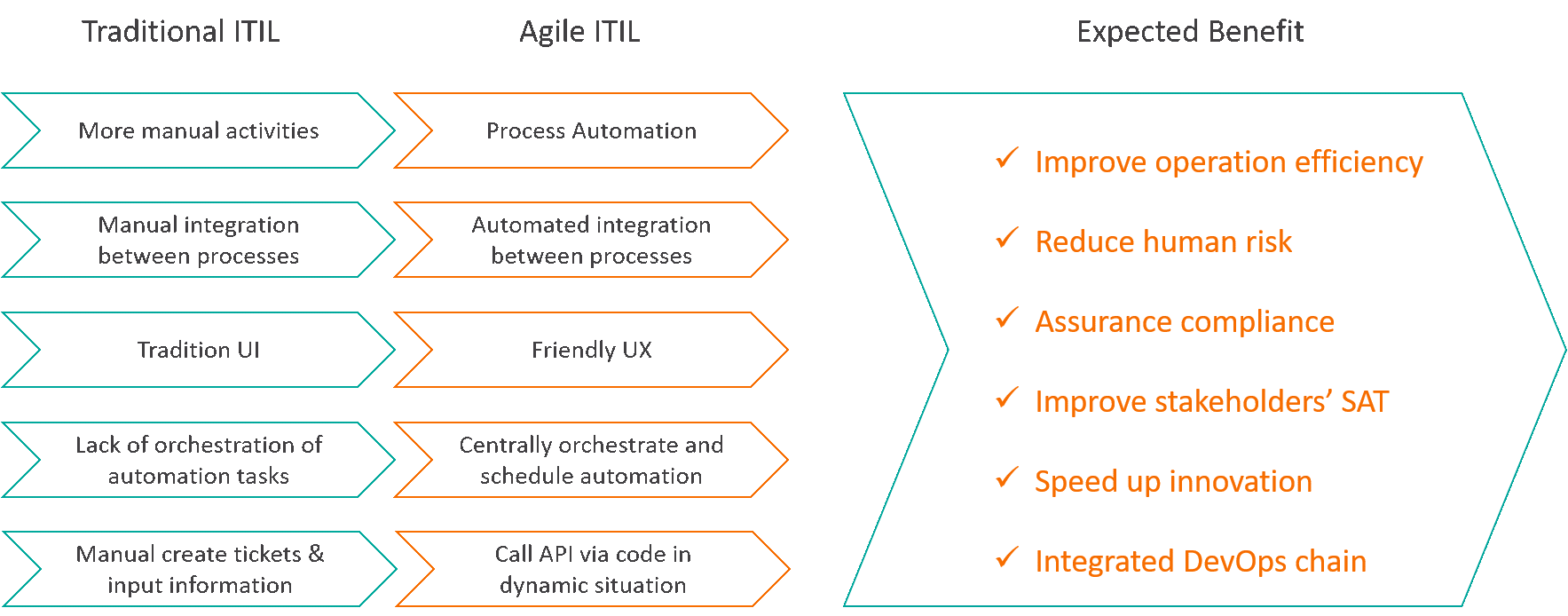
Coming Soon: ITIL 4! Learn more about the newest version of ITIL and how it will continue to prove its relevance in the post-digital world with the addition of many of the enhanced process steps discussed above.
Notes:
1. Is ITIL used at companies such as Amazon, Google, Facebook? Why? – Quora
2. https://www.exin.com/en/certifications/exin-devops-master-exam

